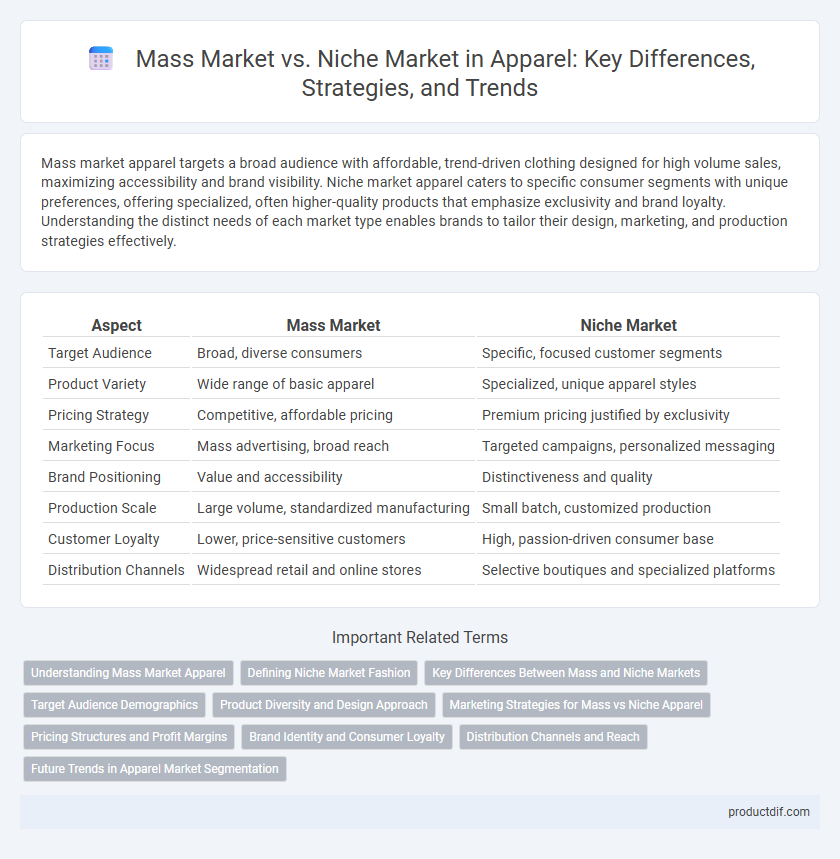Mass market apparel targets a broad audience with affordable, trend-driven clothing designed for high volume sales, maximizing accessibility and brand visibility. Niche market apparel caters to specific consumer segments with unique preferences, offering specialized, often higher-quality products that emphasize exclusivity and brand loyalty. Understanding the distinct needs of each market type enables brands to tailor their design, marketing, and production strategies effectively.
Table of Comparison
| Aspect | Mass Market | Niche Market |
|---|---|---|
| Target Audience | Broad, diverse consumers | Specific, focused customer segments |
| Product Variety | Wide range of basic apparel | Specialized, unique apparel styles |
| Pricing Strategy | Competitive, affordable pricing | Premium pricing justified by exclusivity |
| Marketing Focus | Mass advertising, broad reach | Targeted campaigns, personalized messaging |
| Brand Positioning | Value and accessibility | Distinctiveness and quality |
| Production Scale | Large volume, standardized manufacturing | Small batch, customized production |
| Customer Loyalty | Lower, price-sensitive customers | High, passion-driven consumer base |
| Distribution Channels | Widespread retail and online stores | Selective boutiques and specialized platforms |
Understanding Mass Market Apparel
Mass market apparel targets a broad consumer base with affordable, trendy clothing designed for widespread appeal, emphasizing high production volumes and extensive retail distribution. It prioritizes standardized sizing, seasonal collections, and fast fashion trends to maximize accessibility and drive large-scale sales. Understanding consumer behavior, fabric durability, and price sensitivity is essential for success in this highly competitive segment.
Defining Niche Market Fashion
Niche market fashion targets specific consumer segments with unique preferences, offering specialized apparel that meets distinct style, fit, or ethical criteria often overlooked by mass market brands. This focused approach allows designers to create limited edition or customized clothing that appeals to a dedicated audience, fostering brand loyalty and higher profit margins. Unlike mass market fashion, which prioritizes volume and broad trends, niche fashion emphasizes quality, exclusivity, and personalized marketing strategies.
Key Differences Between Mass and Niche Markets
Mass market apparel targets broad consumer groups with standardized products, emphasizing high volume and affordability, while niche market apparel focuses on specialized segments with tailored designs and premium pricing. Mass market relies on extensive distribution channels and economies of scale, whereas niche market prioritizes personalized customer experiences and limited availability. Product differentiation, marketing strategies, and customer loyalty distinctly separate mass market brands like H&M from niche brands like Patagonia.
Target Audience Demographics
Mass market apparel targets a broad audience, often catering to diverse age groups, income levels, and lifestyle preferences, maximizing volume sales through wide product availability. Niche market apparel focuses on specific demographics, such as eco-conscious millennials or luxury consumers aged 30-45, delivering specialized designs and premium materials that meet unique needs. Understanding these target audience demographics enables brands to tailor marketing strategies and product offerings effectively for either widespread appeal or exclusive customer engagement.
Product Diversity and Design Approach
Mass market apparel emphasizes extensive product diversity with broad design appeal to attract a wide consumer base, prioritizing cost-efficiency and trend responsiveness. Niche market apparel focuses on specialized, unique designs tailored to specific customer segments, often incorporating high-quality materials and innovative styles. This targeted design approach in niche markets fosters brand loyalty and differentiates products from mass-produced offerings.
Marketing Strategies for Mass vs Niche Apparel
Mass market apparel marketing strategies emphasize broad appeal through competitive pricing, extensive distribution channels, and high-volume advertising campaigns to reach a wide audience quickly. Niche apparel marketing focuses on targeted messaging, leveraging specialized social media platforms, influencer partnerships, and personalized customer experiences to build brand loyalty within specific subcultures or demographics. Data-driven insights and customer segmentation are critical for optimizing product positioning and promotional tactics in both mass and niche markets.
Pricing Structures and Profit Margins
Mass market apparel relies on low pricing structures to attract a broad customer base, resulting in thinner profit margins offset by high sales volumes. Niche market apparel utilizes premium pricing, targeting specific consumer segments willing to pay more for exclusivity and quality, leading to higher profit margins per unit. Efficient cost management and brand positioning critically influence profitability within both mass and niche markets.
Brand Identity and Consumer Loyalty
Mass market apparel brands prioritize broad appeal, leveraging consistent brand identity to build widespread consumer loyalty through familiarity and accessibility. Niche market apparel brands cultivate distinct brand personas, fostering deep consumer loyalty by targeting specific lifestyle values and unique fashion preferences. Strong brand identity in both markets drives emotional connection, influencing purchasing behavior and long-term loyalty in highly competitive apparel sectors.
Distribution Channels and Reach
Mass market apparel brands utilize extensive distribution channels including large retail chains, e-commerce platforms, and wholesale distributors, enabling wide geographic reach and high-volume sales. Niche market apparel focuses on specialized boutiques, direct-to-consumer websites, and curated pop-up shops targeting specific customer segments, resulting in limited but highly engaged reach. The choice of distribution channels directly impacts brand visibility, customer accessibility, and overall market penetration in both mass and niche apparel sectors.
Future Trends in Apparel Market Segmentation
Mass market apparel focuses on broad consumer groups with standardized products, while niche market apparel targets specific, highly defined segments with specialized needs. Future trends in apparel market segmentation emphasize personalization through AI-driven customization, sustainable materials tailored to eco-conscious consumers, and adaptive wearable technology that aligns with individual lifestyles. Brands leveraging data analytics and consumer behavior insights will dominate by delivering unique experiences that cater to evolving demand patterns in both mass and niche markets.
Mass market vs Niche market Infographic

 productdif.com
productdif.com